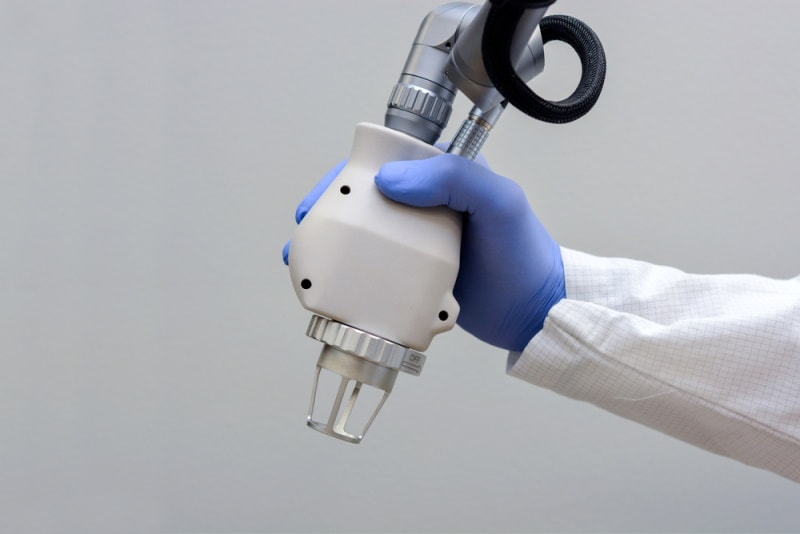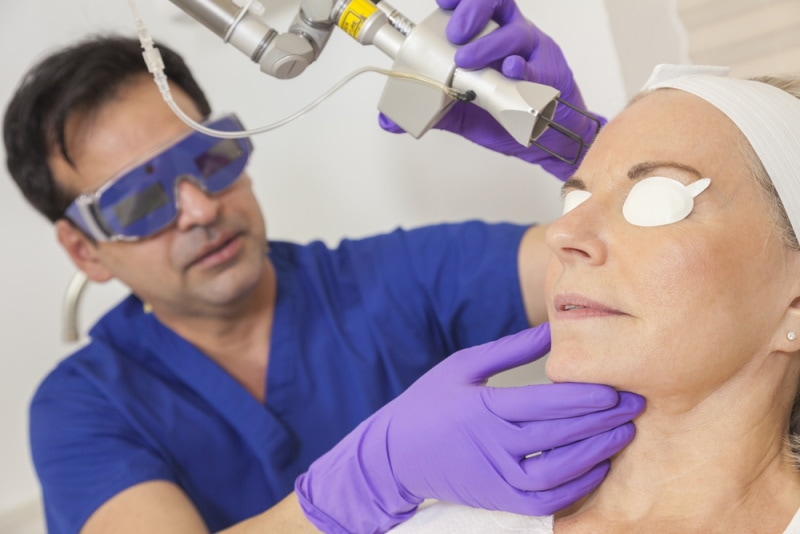How Do CO2 Lasers Work? What to Know!
Last Updated on

If you’ve been dabbling in skin care or surgical studies, you might have come across carbon dioxide lasers and wondered what they do. What are they used for? How do they work? Are there different types of CO2 lasers?
To answer these questions, we’ve made a comprehensive guide to show you all about these tools and what makes them useful tools in the medical field for our skin. In short, CO2 lasers damage or remove certain skin cells and proteins using an extremely hot wavelength. Take a look below to get started!

How Does It Work?
A CO2 laser works by discharging a certain wavelength (10,600 nanometers) which is extremely hot. This ‘laser’ makes it easy to damage or remove skin cells and proteins in the body. In the process, there are several dots that shoot the laser onto the water that’s on the skin. In fact, it’s a type of heat injury that removes skin from the body and creates collagen, a process that’s also known as ablation. They target the top layer of skin and allow for new skin to form.
However, they may only stimulate the skin and not remove it entirely. Vaporization is used for thick skin cells, whereas coagulation is used for thinner, more sensitive skin areas such as around the eyes.
All of this might sound a bit graphic, but we promise it will make more sense in a minute. Keep reading to see why injuring skin cells can be a good option for certain patients.

What Are the Different Types of CO2 Laser Procedures?
There are two main types of CO2 laser skin resurfacing procedures out there, ablative and non-ablative fractional. We’ll discuss them both in detail below.
Ablative
One way that CO2 lasers treat certain skin conditions is by vaporizing the skin at the source with immense heat. This is what ablative skin resurfacing aims to achieve, but more power and higher temperatures are required to remove the whole area. Because the skin is completely removed and it stresses the area a lot, it can be a bit more painful than other options.
Non-Ablative Fractional
These are called fractional because they treat a fraction of the skin rather than an entire area. The results are that the skin isn’t completely removed but instead damaged to an extent that enables it to recover as fast as possible. This procedure is considered to be the most comfortable for patients with skin issues.
Where Is It Used?
Carbon dioxide lasers are used in many medical and surgical applications. To treat people with skin problems such as scarring or some disorders, health professionals use CO2 to remove the skin at the source so new cells can grow in place, improving their recovery and overall skin health. Viral warts and actinic keratosis are other problems that can be solved with the use of this equipment.
Cosmetic surgeons also use these tools if people want to change their physical attributes. This may be within the realm of plastic surgery, but the fact is that many customers desire tighter younger-looking skin. The loose skin may be caused by aging or stretch marks, as well as the result of baggy eyes. Also, some people are looking to remove physical traits like moles or birthmarks because they believe it will enhance their aesthetics.

Advantages of CO2 Lasers
Because they aid in skin regeneration, they are effective in solving issues such as acne (and acne scarring), sunburn, and melasma. Not only that, but cosmetic surgeons can help aging individuals with wrinkles, or patients who wish to get rid of pesky stretch marks. Additionally, the healing time of CO2 procedures compared to natural recovery is much faster, which can get people back to normal sooner.
Disadvantages of CO2 Lasers
There are many inherent dangers to these tools, namely infections, the alteration of skin tones, scarring, or worse recovery times. It all depends on the situation though and these side effects aren’t always present in all patients. Also, they aren’t found in stores so the procedures have to happen through medical treatment.
Frequently Asked Questions (FAQs)
How Much Do CO2 Lasers Treatments Cost?
Like anything in the medical world, these treatments don’t come cheap. Typically, a CO2 laser procedure will cost thousands of dollars. You can expect to pay around $2,000 to $6,000 per visitation, but it may vary if you have complications or several areas that are of concern.
How Long After CO2 Laser Procedures Will I See Results?
Generally speaking, the process can take two or three weeks to start having noticeable differences. That’s because, after the procedure, the skin still has to heal naturally from the damage done to the cells and proteins.

How Often Should You Get CO2 Laser Treatment?
Once you’ve completed your first round of treatment in a specific spot, everything should be set from there on out. Other than an occasional touch-up that may be necessary for some people, you won’t need to return unless there are other questions or concerns that you have.

Final Thoughts
Carbon dioxide lasers seem like science-fiction weapons, but they are actually used for many beneficial purposes in the surgical field. They work by removing or damaging skin so that new cells can regenerate and support the health of a patient. It’s important to know what they do, whether you are looking to improve aesthetics or are a medical professional that wants to know more about these tools.
Featured Image Credit: AlteredR, Shutterstock
About the Author Robert Sparks
Robert’s obsession with all things optical started early in life, when his optician father would bring home prototypes for Robert to play with. Nowadays, Robert is dedicated to helping others find the right optics for their needs. His hobbies include astronomy, astrophysics, and model building. Originally from Newark, NJ, he resides in Santa Fe, New Mexico, where the nighttime skies are filled with glittering stars.
Related Articles:
How to Clean a Refractor Telescope: Step-by-Step Guide
How to Clean a Telescope Eyepiece: Step-by-Step Guide
How to Clean a Rifle Scope: 8 Expert Tips
Monocular vs Telescope: Differences Explained (With Pictures)
What Is a Monocular Used For? 8 Common Functions
How to Clean a Telescope Mirror: 8 Expert Tips
Brightfield vs Phase Contrast Microscopy: The Differences Explained
SkyCamHD Drone Review: Pros, Cons, FAQ, & Verdict
